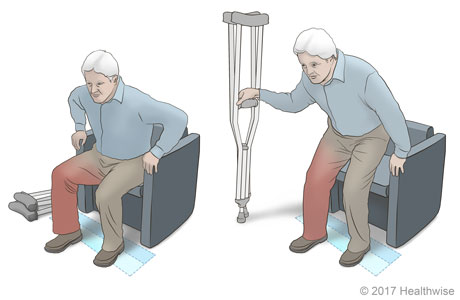Overview
Crutches can help you walk when you have an injured hip, leg, knee, ankle, or foot. Your doctor will tell you how much weight—if any—you can put on your leg.
Be sure your crutches fit you. When you stand up in your normal posture, there should be space for two or three fingers between the top of the crutch and your armpit. When you let your hands hang down, the hand grips should be at your wrists. When you put your hands on the hand grips, your elbows should be slightly bent.
To stay safe when using crutches:
- Look straight ahead, not down at your feet.
- Clear away small rugs, cords, or anything else that could cause you to trip, slip, or fall.
- Be very careful around pets and small children. They can get in your path when you least expect it.
- Be sure the rubber tips on your crutches are clean and in good condition to help prevent slipping.
- Avoid slick conditions, such as wet floors and snowy or icy driveways. In bad weather, be extra careful on curbs and steps.
How to walk with crutches with weight on the injured leg

If you're able to put weight on your weak or injured leg, use the crutches for added support.
- Put both crutches about 12 inches in front of you.
- Put your weight on the handgrips, not on the pads under your arms.
(Constant pressure against your underarms can cause numbness.)
- Swing your body forward.
- To complete the step, put your weight on the strong leg.
- Move your crutches about 12 inches in front of you, and start the next step.
When you're confident using the crutches, you can move the crutches and your injured leg at the same time. Then push straight down on the crutches as you step past the crutches with your strong leg, as you would in normal walking. Use ramps and elevators when you can.
How to walk with crutches without weight on the injured leg

- If you have been told not to put any weight on your injured leg, keep that leg bent and off the ground.
- Bend your elbows slightly.
- Press the padded top parts of the crutches against your sides, under your armpits.
- Put both crutches about 12 inches in front of you.
- Put your weight on the handgrips, not on the pads under your arms.
(Constant pressure against your underarms can cause numbness.)
- Swing your body forward.
- To complete the step, put your weight on the strong leg.
- Move your crutches about 12 inches in front of you, and start the next step.
When you're confident using the crutches, you can move the crutches and your injured leg at the same time. Then push straight down on the crutches as you step past the crutches with your strong leg, as you would in normal walking.
How to sit down and stand up from a chair with crutches
To sit, back up to the chair.

Use one hand to hold both crutches by the handgrips, beside your injured leg.
With the other hand, hold on to the seat and slowly lower yourself onto the chair.
Lay the crutches on the ground near your chair. If you prop them up, they may fall over.
To get up from a chair, pick up the crutches and put them in one hand beside your injured leg.

Put your weight on the handgrips of the crutches and on your strong leg to stand up.
How to go up and down stairs using crutches
Try this first with another person nearby to steady you if needed. And remember "up with the good, down with the bad" to help you lead with the correct leg.
If the stairs don't have a handrail, stand near the edge of the stairs.

To go up, step up with your stronger leg. Then bring the crutches and your weak or injured leg to the upper step.
To go down, put your crutches and your weak or injured leg on the lower step. Then bring your stronger leg down to the lower step.
If the stairs have a sturdy handrail, stand near the edge of the stairs.

Put both crutches under the arm opposite the handrail.
Use the hand opposite the handrail to hold both crutches by the handgrips.
Hold on to the handrail as you go up or down.
To go up, step up with your stronger leg. Then bring the crutches and your weak or injured leg to the upper step.
To go down, put your crutches and your weak or injured leg on the lower step. Then bring your stronger leg down to the lower step.
Follow-up care is a key part of your treatment and safety. Be sure to make and go to all appointments, and call your doctor if you are having problems. It's also a good idea to know your test results and keep a list of the medicines you take.
Where can you learn more?
Go to http://www.healthwise.net/patientEd
Enter G273 in the search box to learn more about "Learning About How to Use Crutches".
Current as of: July 31, 2024
Author: Ignite Healthwise, LLC Staff
Clinical Review Board
All Ignite Healthwise, LLC education is reviewed by a team that includes physicians, nurses, advanced practitioners, registered dieticians, and other healthcare professionals.

